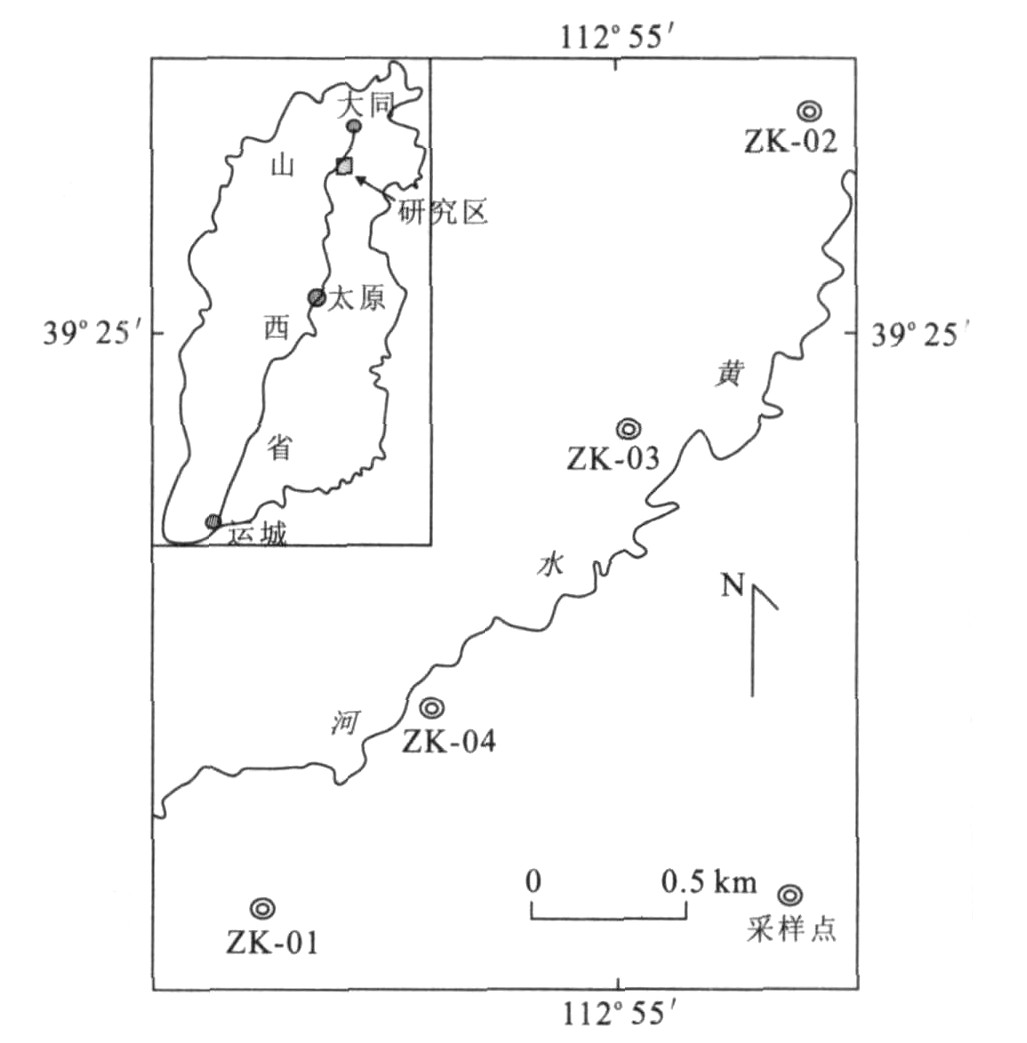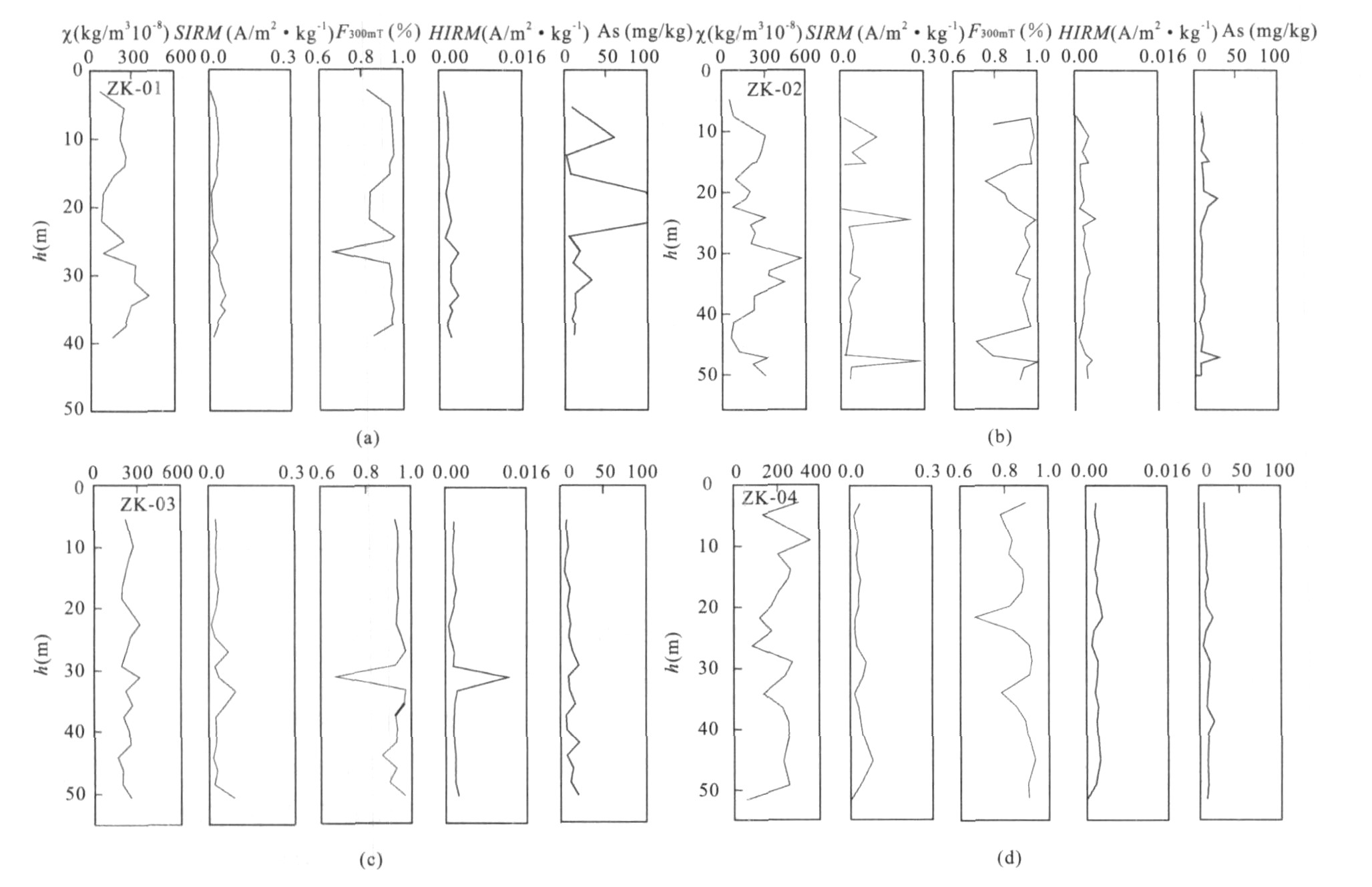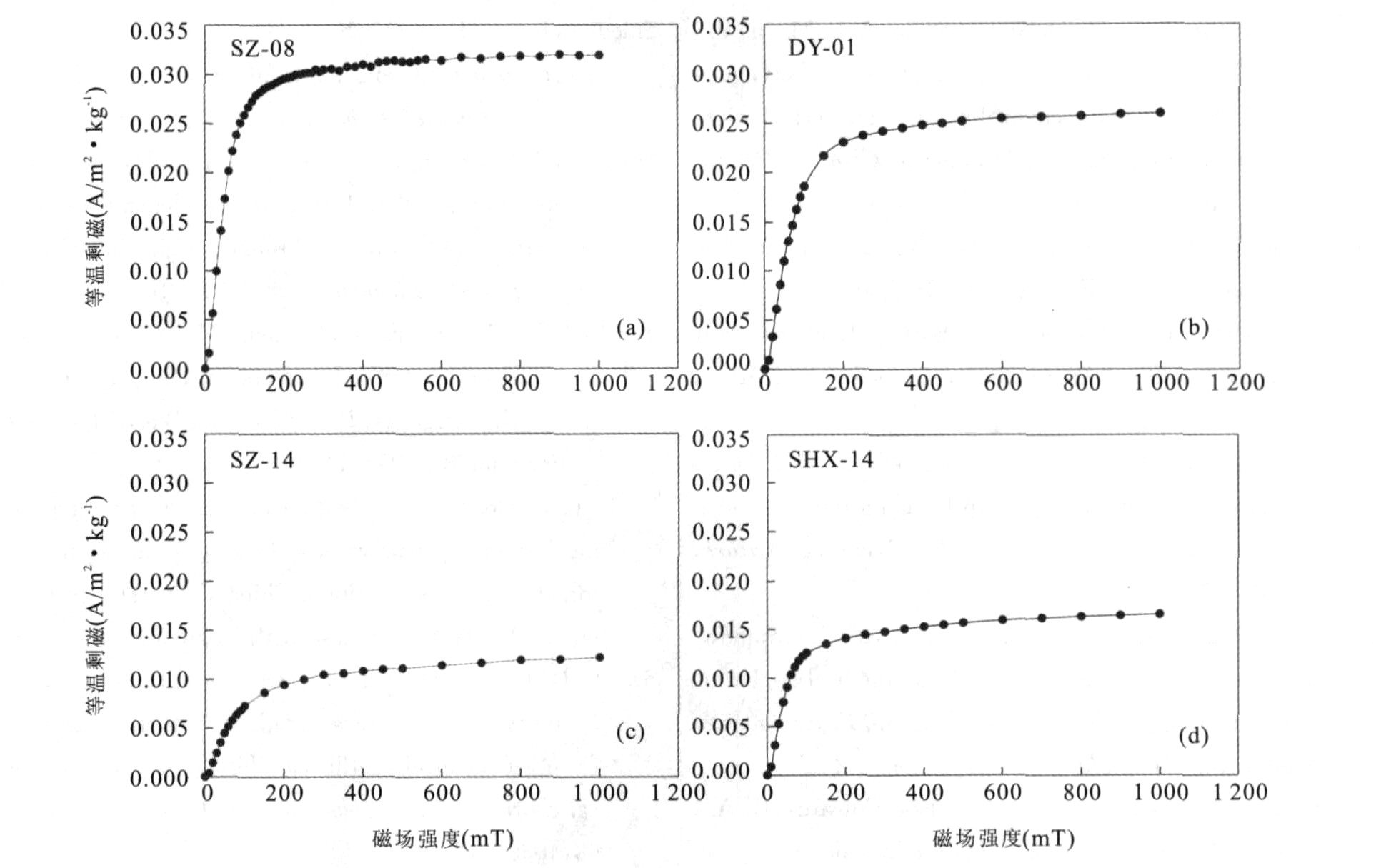Environmental Magnetic Properties of Sediments of High Arsenic Groundwater System, Datong Basin
-
摘要: 为了研究高砷含水层沉积物中砷与磁性矿物的关系, 对大同盆地高砷地区含水层钻孔样品进行了环境磁学和地球化学分析, 结果表明亚铁磁性矿物是决定含水层沉积物磁性特征的主要磁性矿物.通过对比砷和磁性参数在垂向上的变化趋势发现, 高砷含量往往对应着低的饱和等温剩磁(SIRM) 值, 揭示出砷和顺磁性矿物之间也存在联系.沉积物砷含量与磁性参数的相关系数均小于0.5 (α=0.05), 表明砷和亚铁磁性矿物及不完整反铁磁性矿物之间不存在明显的联系.在所有磁性参数中磁化率(χ)和砷含量之间相关性最显著, 相关系数均在0.4 (α=0.05) 左右, 低的相关系数与亚铁磁性矿物和不完整反铁磁性矿物对顺铁磁性矿物的稀释有关.该地区高砷地下水的形成可能与水铁矿及纤铁矿等砷的赋存矿物在还原条件下的还原溶解有关.Abstract: The purpose of the study is to test the possible relationship between magnetic parameters and arsenic in high arsenic aquifer sediment. Magnetic and geochemical study on core sediments from Datong basin suggests that the dominant magnetic mineral is ferrimagnetic. Magnetic measurements and arsenic concentration analysis were carried out to understand the distribution characteristics of magnetic parameters and arsenic in sediments. All core samples with high arsenic content have low saturation isothermal remnant magnetism (SIRM) values, indicating the correlation between arsenic and paramagnetic mineral. The correlation factors between arsenic content and magnetic parameters are very low (R2 < 0.5, α=0.05), but the magnetic susceptibility (χ) is better correlated than the other magnetic parameters with correlation factor of about 0.4 (α=0.05). The low correlation between magnetic proxies and arsenic content is attributed to the dilution of paramagnetic minerals by the ferrimagnetic and anti-ferromagnetic minerals. The occurrence of As-rich groundwater in this region may be due to dissolution of As-bearing Fe mineral (e.g. γFeOOH, 5Fe2O3·9H2O) and subsequent arsenic release.
-
Key words:
- Datong basin /
- arsenic /
- groundwater system /
- sediment /
- environmental magnetism.
-
表 1 大同盆地不同采样点沉积物的环境磁学参数与砷含量统计
Table 1. Statistic of environmental magnetic parameters and arsenic concentrations of core samples from Datong basin

-
Akai, J., Izumi, K., Fukuhara, H., et al., 2004. Mineralogical and geomicrobiological investigations on groundwater arsenic enrichment in Bangladesh. Applied Geochemistry, 19: 215-230. doi: 10.1016/j.apgeochem.2003.09.008 Anawar, H. M., Akai, J., Komaki, K., et al., 2003. Geochemical occurrences of arsenic in groundwater of Bangladesh: Sources and mobilisation processes. Journal of Geochemical Exploration, 77: 109-131. doi: 10.1016/S0375-6742(02)00273-X Berg, M., Tran, H. C., Nguyen, T. C., et al., 2001. Arsenic contamination of groundwater and drinking water in Vietnam: A human health threat. Environmental Science and Technology, 35: 2621-2626. doi: 10.1021/es010027y Bhattacharyya, R., Chatterjee, D., Nath, B., et al., 2003. High arsenic groundwater: Mobilization, metabolism and mitigation—An overviewin the Bengal delta plain. Molecular and Cellular Biochemistry, 253: 347-355. doi: 10.1023/A:1026001024578 Das, D., Samanta, C., Mandal, B. K., et al., 1996. Arsenic ingroundwater in districts of West Bengal, India. Environmental Geochemistry and Health, 18: 5-15. doi: 10.1007/BF01757214 Dowling, C. B., Poreda, R. J., Basu, A. R., et al., 2002. Geochemical study of arsenic release mechanisms in theBengal basin groundwater. Water Resources Research, 38: 1-18. Guo, H. M., Wang, Y. X., Li, Y. M., 2003. Analysis of factor resulting in anomalous arsenic concentration ingroundwater of Shanyin, Shanxi Province. Environmental Science, 24 (4): 60-67 (in Chinese with English abstract). Harvey, C. F., Swartz, C. H., Badruzzaman, A. B. M., et al., 2002. Arsenic mobility and groundwater extraction inBangladesh. Science, 298: 1602-1606. doi: 10.1126/science.1076978 Harvey, C. F., Swartz, C. H., Badruzzaman, A. B. M., et al., 2005. Groundwater arsenic contaminationin the Gangesdelta: Biogeochemistry, hydrology, human perturbations and human suffering on a large scale. Comptus Rendus Geoscience, 337: 285-296. Horneman, A., Van Geen, A., Kent, D. V., et al., 2004. Decoupling of As and Fe release to Bangladesh groundwater under reducing conditions. Part Ⅰ: Evidence fromsediment profiles. Geochimica et Cosmochimica Acta, 68: 3459-3473. doi: 10.1016/j.gca.2004.01.026 Islam, F. S., Gault, A. G., Boothman, C., et al., 2004. Directevidence of arsenic release from Bengal sediments mediated by indigenous metalreducing bacteria. Nature, 430: 68-71. doi: 10.1038/nature02638 Klump, S., Kipfer, R., Cirpka, O. A., et al., 2006. Groundwater dynamics and arsenic mobilization in Bangladesh assessed using noble gases and tritium. Environmental Science and Technology, 40: 243-250. doi: 10.1021/es051284w McArthur, J. M., Banerjee, D. M., Hudson-Edwards, K. A., et al., 2004. Natural organic matter in sedimentary basins and its relation to arsenic in anoxic groundwater: The example of West Bengal and its worldwide implications. Applied Geochemistry, 19: 1255-1293. doi: 10.1016/j.apgeochem.2004.02.001 McArthur, J. M., Ravenscroft, P., Safiullah, S., et al., 2001. Arsenic in groundwater: Testing pollution mechanismsfor sedimentary aquifers in Bangladesh. Water Resources Research, 37: 109-117. doi: 10.1029/2000WR900270 Nickson, R. T., McArthur, J. M., Burgess, W. G., et al., 1998. Arsenic poisoning of Bangladesh groundwater. Nature, 395: 338. doi: 10.1038/26387 Nickson, R. T., McArthur, J. M., Ravenscroft, P., et al., 2000. Mechanism of arsenic release to groundwater, Bangladesh and West Bengal. Applied Geochemistry, 15: 403-413. doi: 10.1016/S0883-2927(99)00086-4 Polya, D. A., Gault, A. G., Bourne, N. J., et al., 2003. Coupled HPLC-ICP-MS analysis indicates highly hazardous concentrations of dissolved arsenic species are present inCambodian well waters. Royal Society of Chemistry Special Publication, 288: 127-140. Polya, D. A., Gault, A. G., Diebe, N., et al., 2005. Arsenichazard in shallow Cambodian groundwaters. Mineralogical Magazine, 69: 807-823. doi: 10.1180/0026461056950290 Shen, M. J., Hu, S. Y., Blaha, U., et al, 2006. Magnetic responses to heavy metal pollution and its statistic significance for site722soil vertical profile in eastern Beijing. Earth Science—Journal of University of Geosciences, 31 (3): 399-404 (in Chinese with English abstract). Smedley, P. L., Kinniburgh, D. G., 2002. A review of thesource, behaviour and distribution of arsenic in naturalwaters. Applied Geochemistry, 17: 517-568. doi: 10.1016/S0883-2927(02)00018-5 Smedley, P. L., Zhang, M., Zhang, G., et al., 2003. Mobilisation of arsenic and other trace elements in fluviolacustrine aquifers of the Huhhot basin, Inner Mongolia. Applied Geochemistry, 18: 1453-1477. doi: 10.1016/S0883-2927(03)00062-3 Smith, A. H., Lingas, E. O., Rahman, M., 2000. Contamination of drinking-water by arsenic in Bangladesh: A public health emergency. Bulletin of the World Health Organisation, 78: 1093-1103. Su, C. L., 2006. Regional hydrogeochemistry and genesis of high arsenic groundwater at Datong basin, Shanxi Province, China[Dissertation]. China University of Geosciences, Wuhan (in Chinese with English abstract). Swartz, C. H., Blute, N. K., Badruzzman, B., et al., 2004. Mobility of arsenic in a Bangladesh aquifer: Inferences from geochemical profiles, leaching data and mineralogical characterisation. Geochimica et Cosmochimica Acta, 68: 4539-4557. doi: 10.1016/j.gca.2004.04.020 Thompson, R., OldFeld, F., 1986. Environmental magnetism. Allen and Unwin, London, 1-227. US EPA., 2001. Method200.9: Trace elements in water, solids and biosolids by stabilized temperature graphite furnace atomic absorption spectrometry. EPA-821-R-01-011, U. S. A. . Wang, J. H., Zhao, L. S., Wu, Y. B., 1998. Environmental geochemical study on arsenic in arseniasis areas in Shanyin and Yingxian, Shanxi Province. Geoscience, 12 (2): 243-248 (in Chinese with English abstract). Wang, X. S., Qin, Y., 2006. Relation between sulfur and magnetic parameters in Xuzhou urban topsoils and itsenvironmental significance. Environmental Herald, 24 (7): 48-50 (in Chinese with English abstract). World Health Organization (WHO), 1996. Guidelines fordrinking water quality., 2nd ed., Health criteria and other supporting information, vol. 2., Geneva, Switzerland. Zhang, W. G., Yu, L. Z., 2002. Relationship between granularity and magnetic properties in intertidal sediments of the Yangtze Estuary, China. Science in China (Seri. D), 32 (9): 783-792 (in Chinese). Zhang, W. G., Yu, L. Z., Lu, M., 2003. Relationship betweeniron oxides and magnetic properties in intertidal sediments of the Yangtze Estuary, China. Chinese Journal of Geophysics, 46 (1): 79-85 (in Chinese with Englishabstract). Zheng, Y., Stute, M., Van Geen, A., et al., 2004. Redoxcontrol of arsenic mobilisationin Bangladesh groundwater. Applied Geochemistry, 19: 201-214. doi: 10.1016/j.apgeochem.2003.09.007 郭华明, 王焰新, 李永敏, 2003. 山阴水砷中毒区地下水砷的富集因素分析. 环境科学, 24 (4): 60-67. https://www.cnki.com.cn/Article/CJFDTOTAL-HJKZ200304010.htm 沈明洁, 胡守云, Blaha, U., 等, 2006. 北京西郊722土壤垂向剖面重金属污染的磁学响应及其统计意义. 地球科学——中国地质大学学报, 31 (3): 399-404. https://www.cnki.com.cn/Article/CJFDTOTAL-DQKX200603018.htm 苏春利, 2006. 大同盆地区域水文地球化学与高砷地下水成因研究[博士学位论文]. 武汉: 中国地质大学. 王敬华, 赵伦山, 吴悦斌, 1998. 山西山阴、应县一带砷中毒区砷的环境地球化学研究. 现代地质, 12 (2): 243-248. https://www.cnki.com.cn/Article/CJFDTOTAL-XDDZ802.014.htm 王学松, 秦勇, 2006. 徐州城市表层土壤中硫与环境磁学参数的关系及其环境意义. 环境导报, 24 (7): 48-50. https://www.cnki.com.cn/Article/CJFDTOTAL-KJDB200607019.htm 张卫国, 愈立中, 2002. 长江口潮滩沉积物的磁学性质及其与粒度的关系. 中国科学(D辑), 32 (9): 783-792. https://www.cnki.com.cn/Article/CJFDTOTAL-JDXK200209009.htm 张卫国, 愈立中, 陆敏, 2003. 长江口潮滩沉积物氧化铁与磁性特征和的关系. 地球物理学报, 46 (1): 79-85. doi: 10.3321/j.issn:0001-5733.2003.01.013 -










 下载:
下载:



